Preserving the legacy of voting rights
Interpretive center opens 55 years after Selma to Montgomery March
by The National Center for the Study of Civil Rights and African-American Culture, Alabama State University
Contributing authors for this article include: Janice R. Franklin, Ph.D., Dean, Levi Watkins Learning Center/Project Director; Dorothy A. Autrey, Ph.D., Retired Professor of History/Program Chair; Howard O. Robinson II, Ph.D., University Archivist/Adjunct Professor of History; Destiny Williams, Access Services/Cultural Heritage Manager.
Fifty-five years after Dr. Martin Luther King, Jr. spoke the historic words, “How Long, Not Long,” challenging America to live up to its democratic principles at the end of the 1965 Voting Rights March, a new National Park Service (NPS) Interpretive Center opened February 2020 in Montgomery, Alabama on the campus of Alabama State University (ASU). The Montgomery site completes the Selma to Montgomery National Historic Trail. Two other interpretive centers preserving voting rights history were previously opened in the Black belt areas of Selma and Lowndes County, Alabama.
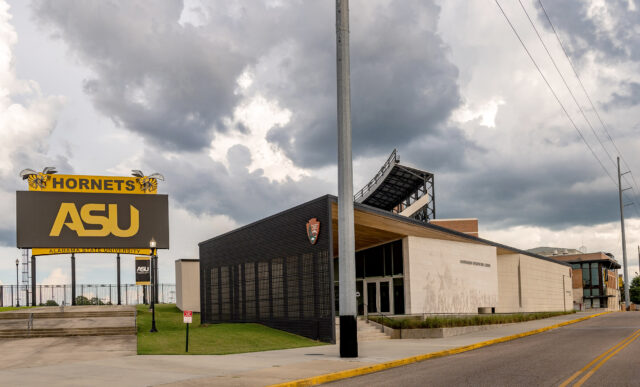
Photo Credit: David Campbell, University Photography
The Montgomery Interpretive Center for the Selma to Montgomery National Historic Trail at Alabama State University opened in spring 2020, the 55th anniversary of the Selma to Montgomery March.
Dr. Joy Kinard, Superintendent of the Selma to Montgomery National Historic Trail, stated that the trail “symbolizes a tangible and intangible manifestation of the American journey toward civil rights. When visiting the 54-mile trail between Selma and Montgomery, AL, visitors will witness the protesters’ struggles through exhibits, oral histories, and displays encountered in three visitor centers while driving, hiking, or biking.”
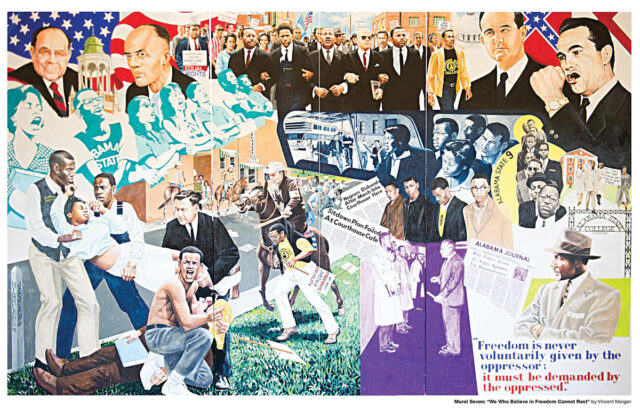
”We Who Believe in Freedom Cannot Rest” by John Feagin, muralist, and Vincent Morgan, artist, is part of “The Journey to Freedom” mural series at the National Center for the Study of Civil Rights and African-American Culture at Alabama State University. It features a quote by Dr. Martin Luther King, Jr., “Freedom is never voluntarily given by the oppressor; it must be demanded by the oppressed.” Photo Credit: ASU Archives.
The National Park Service considered Montgomery as an ideal location for its third interpretive center along the Selma to Montgomery National Historic Trail. The city established its place in history as the capital of Alabama and the cradle of the Confederacy, slaveholding States which seceded from the United States in 1861. Nearly a century later, Montgomery became known as the birthplace of the modern civil rights movement when its Black citizens launched a boycott against segregated bus service and the indignities they suffered on the Jim Crow vehicles. Montgomery also became a center of civil rights activities during the Sit-In Movement, the Freedom Rides, and Voting Rights Campaign.
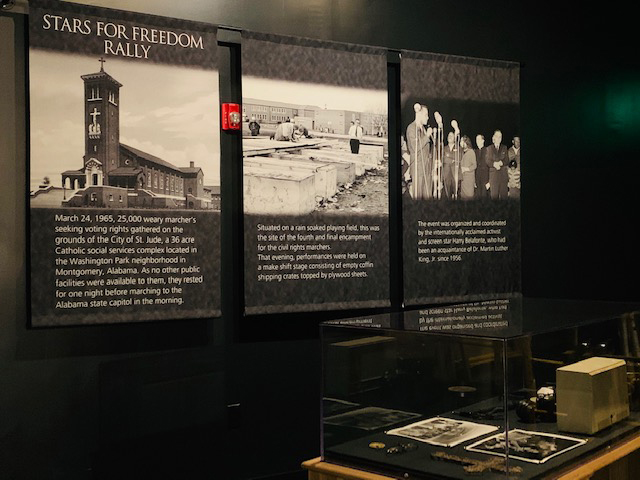
Montgomery Interpretive Center Exhibit Space
Photo Credit: National Park Service
The NPS selected ASU as the site for the third voting rights interpretive center because of its history in civil rights activism. “Alabama State University is honored to have been selected as the site for the new Montgomery Interpretive Center which preserves the rich civil rights legacy of the institution,” said ASU President Quinton T. Ross, Jr. “This partnership fosters opportunities for teaching and learning within the context of higher education and builds on the preservation mission of the National Park Service.” The University was one of many Historically Black Colleges and Universities (HBCUs) founded in the aftermath of the Civil War (1861-1865). These institutions produced outstanding graduates and provided primary, secondary, and college education for African Americans. HBCUs were essential to the civil rights protests and voting rights demonstrations which led to the overthrow of laws and practices that reduced Blacks to second class citizenship status.
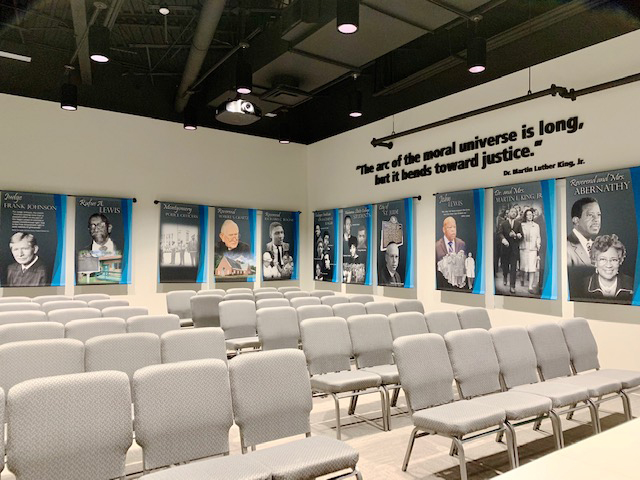
Theater and additional exhibit space in the Montgomery Interpretive Center.
Photo Credit: National Park Service
“We know that progress is not always linear. Today, as we celebrate the signing of the landmark Voting Rights Act (VRA) of 1965, we must also be realistic about how far we have to go in guaranteeing the most fundamental American right—the right to vote. As we reflect upon the past, let us also recommit ourselves to the future. This year, I was thrilled that the House of Representatives finally passed H.R. 4, which restores those crucial pieces of the VRA gutted by the Supreme Court in Shelby v. Holder. We cannot allow it to languish in the Senate. Just as we did in the 1960s, we must make our voices heard and ensure that all Americans are guaranteed their right to vote.”
—Congresswoman Terri Sewell, U.S. Representative, 7th Congressional District of Alabama
In the spring of 1965, students from ASU, Tuskegee University, colleges around the nation, and from area high schools joined the ongoing voting rights crusade in Selma, AL. Following Bloody Sunday, when police attacked nonviolent demonstrators attempting to march to the Alabama State Capitol, the students carried out voting rights protests in Montgomery. Several of these protests emanated from the ASU campus.
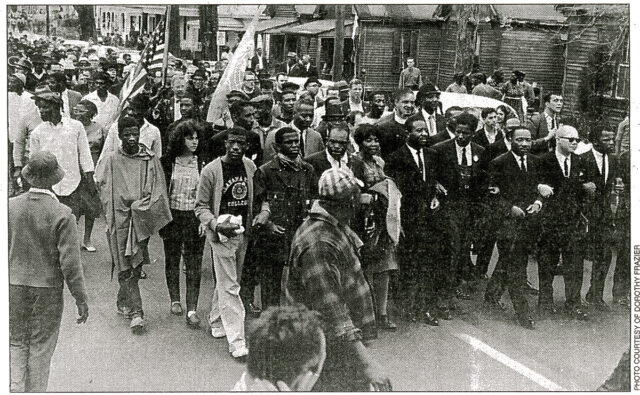
Representatives of the Southern Christian Leadership Conference, the Student Nonviolent Coordinating Committee, the Montgomery Improvement Association, and Alabama State University leading a voting rights march of 4,000 participants in Montgomery, Alabama (March 17, 1965). Photo Credit: Dorothy Frazier Collection, ASU Archives
The students’ participation in the 1965 voting rights protests signaled a new chapter in American history which paved the way for the passage of the historic 1965 Voting Rights Act. This legislation was signed into law by President Lyndon B. Johnson. This act overturned barriers to the ballot, including a literacy test which kept even educated Blacks from registering to vote. The measure resulted in the registration of thousands of new Black voters and the election of African Americans to local, State and national offices.
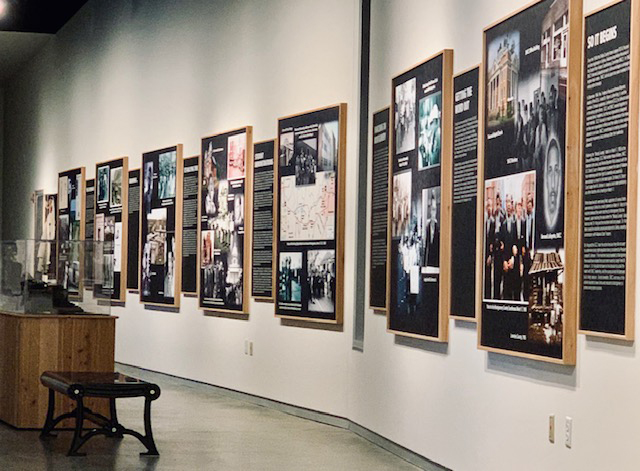
Montgomery Interpretive Center Exhibit Space
Photo Credit: National Park Service
In 2020, the year of the 55th anniversary of the Selma to Montgomery Voting Rights campaign, the American people are yet again at the intersection of racism and widespread activism, challenging the government to hold true to the principles of its Constitution. Just as the murder of Jimmie Lee Jackson in 1965 by Alabama State Troopers led to the Selma to Montgomery Voting Rights March, the murders of numerous unarmed Black citizens by police officers have resulted in social and political unrest in 2020. The current generation of civic-minded citizens stands on the shoulders of previous activists who agitated for the vote as a means to effect policy changes to ensure justice and equality in American society.
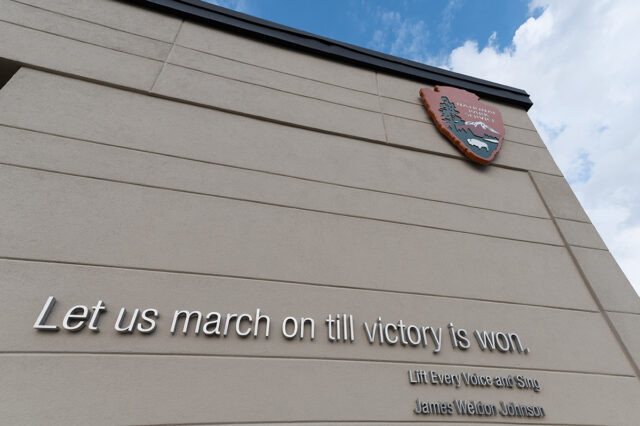
Photo Submitted by NPS of the exterior of the Montgomery Interpretive Center for the Selma to Montgomery National Historic Trail at Alabama State University. “Let us march on till victory is won,” by James Weldon Johnson.
The Montgomery Interpretive Center is a treasure that will be heralded by visitors worldwide. The opening of this new center provides an opportunity to learn lessons from the past while moving forward to a more just and democratic society. Yes, the past meets the present, and understanding our past is as essential today as it was 55 years ago.
Learn more about ASU’s National Center for the Study of Civil Rights and African-American Culture and the history of the Selma to Montgomery NHT: